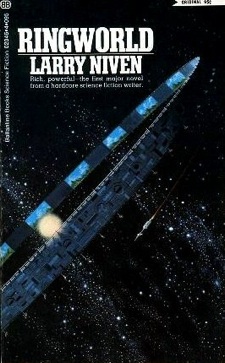In “The Eye of The Storm,” Chapter 17 of Larry Niven’s Ringworld Nessus prompts Louis to think about what he’d find if he landed anywhere on Ringworld and dug. After Louis replies “Ringworld floor material,” Louis has a revelation:
And as he said these words, the landscape seemed to alter…now the landscape showed as the shell it was. The difference between an honest planet and this was the difference between a human face and an empty rubber mask.
In Chapter 23, “The God Gambit,” Louis compares Teela to a mask in the shape of a girl, using much the same words and images that he previously used in describing the Ring. The similarity is striking, and it highlights a major theme in Ringworld—the idea of seeing the familiar in a new light, and learning that it is not what it first appeared to be (hence the title of this post, taken from T. S. Elliot’s poem “Little Gidding”).
Throughout the novel, Louis’s (and the readers’) perceptions of what is being seen and experienced are repeatedly reversed. An early example is Louis Wu himself, first described to the reader as a Fu Manchu figure, complete with robe. But this is mere costume; Louis is really a citizen of Earth whose ancestry can’t be isolated to a single race or ethnicity other than “flatlander.” A more subtle example is what occurs in Louis’ first conversation with Teela Brown—when he describes his relationship with her ancestor as causing “whiplash of the heart,” Louis takes her incomprehension of the meaning of that phrase as a sign of his age and estrangement from human experience, only realizing much later that it signifies Teela’s estrangement, not his.
Another significant example is highlighted by Niven’s use of “Fist-of-God” as the title of both the twelfth and the last chapter of Ringworld. Louis’ initial impression of the mountain is that it is a symbol of the Ringworld engineers’ whimsy and power (he muses that “every world should have at least one unclimbable mountain” and “I’m going to like the Ringworld engineers”). In the final chapter, the mountain is revealed to be a symbol of the Ringworld engineers’ failure to protect the Ringworld from a meteor that rang the Ring like a bell, and also becomes the key to allowing Louis and company to escape. These repeated reversals of initial perceptions and beliefs feed the readers’ “sense of wonder” by suggesting that every aspect of the world may turn out to be vastly different than it appears, but they also contribute to the theme of Ringworld, which is an extended examination of the ideas of safety and risk.
The passages comparing Teela and the Ringworld are the key to this theme. The Ringworld and Teela’s luck both appear to be ways to achieve perfect safety—by creating a lucky human and by engineering a whole world to suit one’s needs; both turn out to be masks that hide shallowness (literally and figuratively) making them into traps. Teela has been stunted psychologically by her luck and left unable to empathize with the pain of others, in spite of her clear intelligence. (Note that on several occasions she figures out aspects of the Ring before Louis does, most noticeably when she identifies the purpose of the Ring’s radiator fins as soon as they become visible, figures out how long the ship has been in stasis after being struck by the defense laser, and when she calculates the required thickness of the Ring in her head.) Meanwhile, the Ring as originally designed seems ideal—three million Earth’s worth of surface area for a population, with an environment throughout that is as pleasant as the best places on Earth. But it too is a trap, since if civilization collapses, the lack of easily accessible resources will make it very difficult for it to arise again. Teela and the Ring are meant for each other indeed—Teela gets to experience dangers at least vicariously and learns to be fully human, while the Ringworld gets Teela, who is the potential ancestor of a civilization of lucky humans who can inhabit, refurbish and protect it.
The theme of risk versus safety is further illuminated by Louis, Speaker and Nessus. Each has a different way of balancing risk and safety. Nessus and his entire species make hubristic attempts to acquire safety through control of all possible dangers. Speaker and his people pursue safety through intimidation of every possible threat. The “middle way” that Louis uses proves to be safer than either of those extremes. Furthermore, Prill’s people provide an example of the ironic dangers of maximizing local, near-term safety. The collapsed Ringworld civilization could have rebuilt if Prill’s people had been willing to risk their hoards of stored power to do so (as Nessus describes in Chapter 21), but instead they pursued short-term safety dooming them and their descendants to a cascading decline.
When Louis returns to Fist-of-God at the climax of the novel, he sees it with new eyes, allowing him to find a way to escape from the trap of the Ring. Meanwhile, Nessus has been humbled by the failure of his plan to create a lucky human to be his lucky charm, and Speaker has learned that some threats are too dangerous to confront by screaming and leaping. The reader, having seen the promises of perfect luck and designed paradise revealed as traps, will see their own world with new eyes as well.
Andy Love is an electrical engineer and science fiction fan with an interest in using science fiction for education; in 2001, he won the Analog-sponsored “Webs of Wonder” for his website on that topic, and he frequently uses Niven stories in his examples of the “Science in Science Fiction” in presentations to a variety of audiences. Some of Andy’s writing about the Ringworld and about the science in science fiction can be found online at these links along with a downloadable document here.










